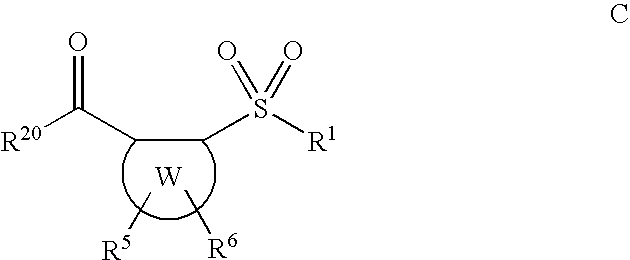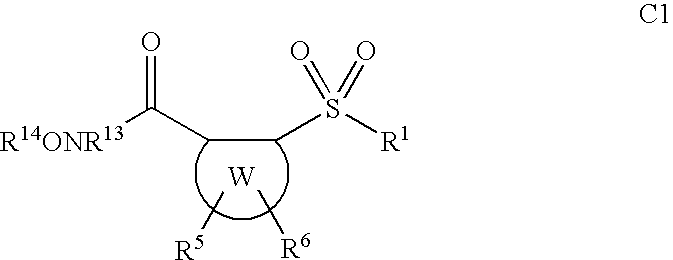Sulfonyl aryl or heteroaryl hydroxamic acid compounds
a technology of sulfonyl aryl and heteroaryl hydroxamic acid, which is applied in the direction of heterocyclic compound active ingredients, biocide, drug compositions, etc., can solve the problems of inability to repair defective injuries, number of disease states, and inability to properly heal wounds, etc., to inhibit the activity, inhibit the activity, and the effect of little activity
- Summary
- Abstract
- Description
- Claims
- Application Information
AI Technical Summary
Benefits of technology
Problems solved by technology
Method used
Image
Examples
example 1
N-hydroxy-2-[[(4-phenoxyphenyl)sulfonyl]methyl]benzamide
[0549]
[0550]Part A: To a solution of phthalide (6.30 g, 47.0 mmol) in DMF (100 mL) was added K2CO3 (10.0 g, 49.4 mmol) and 4-(phenoxy)benzenethiol (9.59 g, 49.4 mmol) and the solution was heated to one hundred degrees Celsius for 2 hours. The solution was diluted with H2O and acidified with 1N HCl to pH=1. The resulting tan solid was collected and washed with H2O. The solid was dissolved into ethyl ether and dried over MgSO4. Concentration in vacuo followed by recrystallization (ethyl ether / hexane) provided the sulfide as a white solid (9.12 g, 58%). MS(CI) MH+ calculated for C20H16O3S: 337, found 337. Analytical calculation for C20H16O3S: C, 71.41; H, 4.79; S, 9.53. Found: C, 71.28; H, 4.67; S, 9.19.
[0551]Part B: To a solution of the sulfide of Part A (3.00 g, 8.92 mmol) in dichloromethane (28 mL) and DMF (1 drop) was added oxalyl chloride (1.08 mL, 12.4 mmol) and the solution was stirred for one hour. After concentration in v...
example 2
N-hydroxy-2-[(4-phenoxyphenyl)sulfonyl]benzeneacetamide
[0553]
[0554]Part A: To a solution of 4-(phenoxy)benzenethiol (6.06 g, 30.0 mmol) and K2CO3 (4.55 g, 33.0 mmol) in isopropanol (30 mL) was added 2-fluorobenzaldehyde (3.2 mL, 30.0 mmol). The solution was refluxed for 20 hours. The reaction was quenched by the addition of ice-H2O and was extracted with CHCl3. The organic layer was dried over MgSO4. Filtration through a pad of silica gel provided the sulfide as a yellow solid (7.43 g, 81%).
[0555]Part B: A solution of NaH (60% dispersion in mineral oil, washed with hexane, 264 mg, 6.6 mmol) in THF (12 mL) was cooled to zero degrees Celsius and tetraethyl dimethylammoniummethylene diphosphonate (1.99 g, 6.0 mmol) was added. The solution was warmed to ambient temperature and the sulfide of Part A (1.84 g, 6.0 mmol) was added. The solution was stirred for 4 hours at ambient temperature. The solution was extracted with ethyl acetate and washed with H2O and dried over MgSO4. Concentratio...
example 3
N-hydroxy-2-[[4-(phenylmethyl)-1-piperidinyl]sulfonyl]benzamide
[0559]
[0560]Part A: To a solution of 2-chlorosulfonylbenzoic acid ethyl ester, prepared per Nagasawa, et. al. J. Med. Chem. 1995, 38, 1865–1871, (5.80 g, 23.0 mmol) in acetonitrile (50 mL) was added 4-benzylpiperidine (4.38 mL, 25 mmol), triethylamine (3.78 mL, 27 mmol) and 4-dimethylaminopyridine (50 mg). The solution was stirred for 4 hours at ambient temperature and concentrated in vacuo. The residue was dissolved into 1N HCl and extracted with ethyl acetate. The organic layer was dried over MgSO4 and filtered through a pad of silica gel to provide the sulfonamide as an oil (7.45 g, 84%).
[0561]Part B: To a solution of the sulfonamide of Part A (1.08 g, 2.80 mmol) in methanol (50 mL) and H2O (20 mL) was added KOH (2 g) and the solution was stirred for 3 hours at ambient temperature. The solution was concentrated in vacuo and the remaining aqueous solution was acidified with 1N HCl. The solution was extracted with chlor...
PUM
| Property | Measurement | Unit |
|---|---|---|
| body weight | aaaaa | aaaaa |
| temperature | aaaaa | aaaaa |
| temperature | aaaaa | aaaaa |
Abstract
Description
Claims
Application Information
 Login to View More
Login to View More - R&D
- Intellectual Property
- Life Sciences
- Materials
- Tech Scout
- Unparalleled Data Quality
- Higher Quality Content
- 60% Fewer Hallucinations
Browse by: Latest US Patents, China's latest patents, Technical Efficacy Thesaurus, Application Domain, Technology Topic, Popular Technical Reports.
© 2025 PatSnap. All rights reserved.Legal|Privacy policy|Modern Slavery Act Transparency Statement|Sitemap|About US| Contact US: help@patsnap.com



